The Alphacool Eisbaer 240 CPU AIO Liquid Cooler Review
by E. Fylladitakis on August 1, 2016 9:00 AM EST- Posted in
- Cases/Cooling/PSUs
- AIO
- Water Cooling
- Cooler
- Alphacool
The Alphacool Eisbaer 240 CPU Liquid Cooler
Even though the radiator of the Eisbaer strongly resembles the radiators of many other AIO liquid coolers, the rest of the assembly is unique compared to any other that we have seen up to this date. To begin with, while the Eisbaer is upplied assembled and prefilled but it actually is a standard liquid cooling kit, as the tubing is not permanently attached on either the radiator or the block/pump assembly. Typical tubing compression fittings are used on both parts that can be undone at any time by the user.
The glossy black tubing of Eisbaer appears to be made out of PVC and has an internal diameter of 11 mm, which is much more than sufficient for a simple system with just one block. A black spring surrounds the glossy black tubing, preventing it from kinking when taking sharp turns. Alphacool also included a plastic connector on one of the tubes, offering the option of relatively quick future upgrades.
The radiator of the Eisbaer may be visually almost identical with the radiators used by many other products. A closer inspection however reveals a major difference: both the channels and the fins of this radiator are made out of copper. This makes the radiator a little heavier and considerably more expensive to manufacture, but it should also offer a noteworthy performance boost. The company logo can be seen printed on the sides of the steel frame.
Eisbaer’s block/pump assembly is quite tall but not very wide, with a plastic body and a copper base. There is a fill tap on the top of the assembly, allowing the user to refill and maintain the system. The company’s logo has LED lights installed and will illuminate blue once the pump is powered on. A little window on the side reveals the pump and fluid to the user. As this would not be visible from the side panel of the case, Alphacool did not install LEDs inside the block.
Inside the assembly we can see one of Alphacool’s pump designs based on the DC-LT Ceramic 12V pumps. The maximum flow is 70 L/h and it has a head of 0.85 m, figures that may not be great compared to those of large external pumps, yet are impressive for such a small device.
The copper base of the cooler is very smooth and appears to have been machined down to a perfect mirror finish. Unfortunately, copper is very easily oxidized and we received one of the pre-production samples that only had a temporary protective sticker attached. It was not attached well and the trapped air oxidized the base of our sample, creating an abstract canvas. This cannot and will not affect the performance of the cooler in any way, it is a mere aesthetic mishap that degrades the appearance of the product.


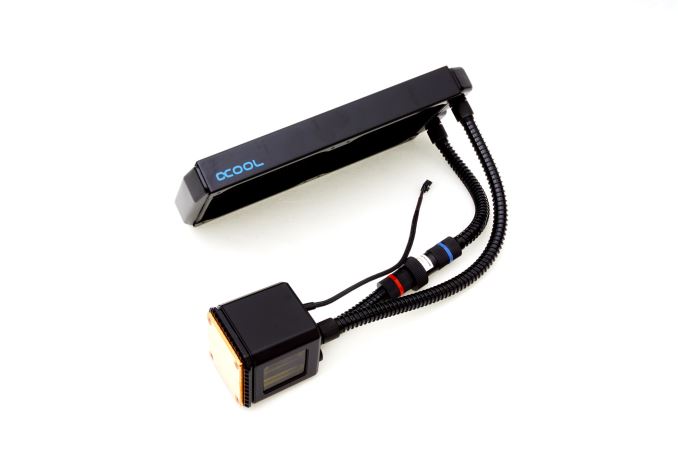
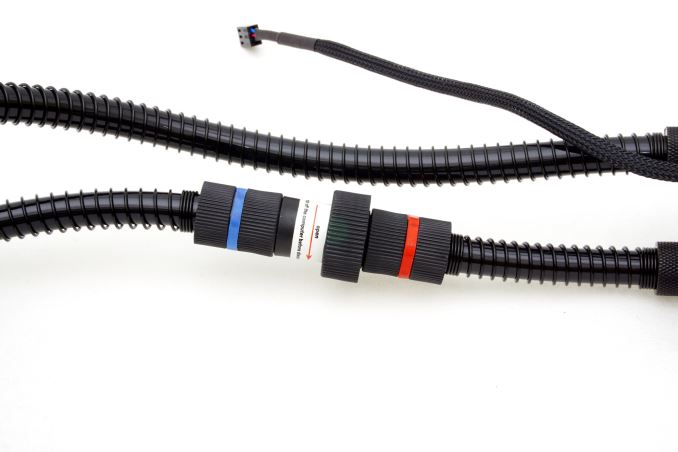
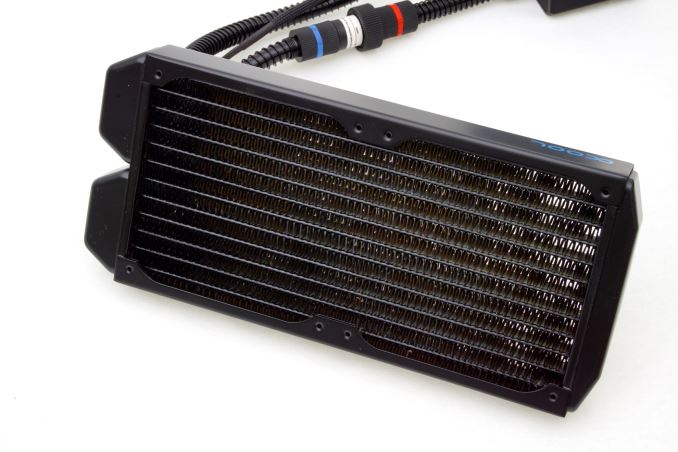
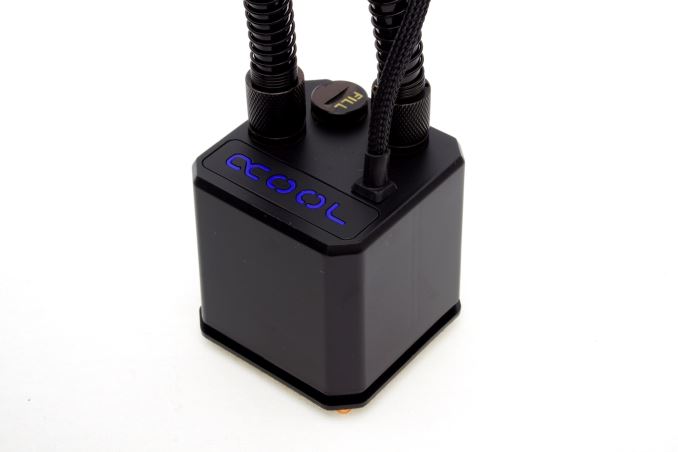
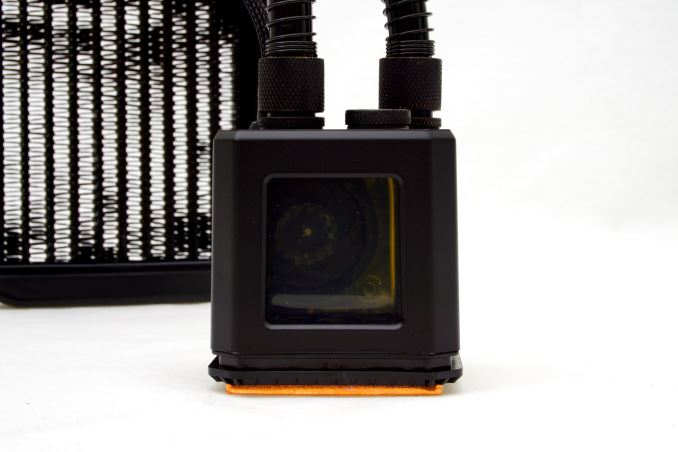









69 Comments
View All Comments
Death666Angel - Tuesday, August 2, 2016 - link
Totally. liquid cooling in the end functions the same way as air cooling, since the water has to be cooled down by air cooling. It only functions as a quick way to get rid of the heat at the source, but then you need radiators (like traditional heatsinks have directly on the CPU/GPU) to get rid of the heat from the water. But since custom liquid cooling is not restricted to the space around the CPU socket or on the graphics card, you can have much more cooling area. I myself have a 2x2x120mm radiator and another 200x200mm radiator, that is probably a bit more area than a high end air cooling CPU and GPU HSF have combined. But I also have that installed in a mATX case. People who go higher end have several 280, 360 radiators installed in their cases or they go 9x120 or 9x140 with external radiators. That is much more cooling area than traditional socket and graphics card coolers can provide.retrospooty - Tuesday, August 2, 2016 - link
You can... But you need to find a quiet water pump. It may also be quiet day one and get louder over time. The other thing is the water pump and the power control behind it introduce 2 additional potential fail points... It just doesn't make a whole lot of sense if building a new system today. Skylake CPU's are very cool and fan noise on them can be zero or near zero even if you are overlocking the crap out of it.Death666Angel - Tuesday, August 2, 2016 - link
"custom loop cool" "Skylake CPU"No one in their right mind uses a custom liquid cooling solution just for the CPU. And since modern rigs can still easily produce 400 to 500W of excess heat if overclocked to their maximum (and that is just for the entry level enthusiast gear), water cooling still makes sense in those cases.
Also, pumps have been nearly silent for years and tests have shown that high water flow isn't really necessary for good cooling temperatures. So something like a throttled Phobya DC12-220 will provide enough power to give you 80l/h at throttled speeds with a CPU+GPU+2 radiators setup and run silently if you decouple it from the case and dampen it with rubber.
How does a WC setup get louder over time and air cooling does not? Mine does get slightly worse performance after a few months of not cleaning the radiator fans. But the same is true of air cooling. That's what a vacuum and compressed air is for. If you are talking about having gunk in your coolers, that shouldn't happen if you set it up right.
I've had a custom WC setup for nearly 6 years now, I've changed the graphics cards one and the cpu/MoBo once and cleaned everything when I did that. First time I had some gunk in the coolers which reduced the flow rate (I didn't use the right ratio for the water additives). Second time I had some gunk but no reduction in flow rate. Now I've not touched it for over a year and the flow rate is steady.
retrospooty - Tuesday, August 2, 2016 - link
I would agree, but it is said in relation to the article above on the Eisbaer 240 "CPU" AIO Liquid Cooler.Death666Angel - Tuesday, August 2, 2016 - link
"Can you make a custom loop cool better AND be quieter than a high end air tower?"Just because it is posted below this review, does not mean you should ignore what he actually asked.
retrospooty - Tuesday, August 2, 2016 - link
I am not sure what you are getting at... I answered his question. He said nothing about a video card, you said that after my post.HomeworldFound - Tuesday, August 2, 2016 - link
An Aquacomputer D5 paired with an Aquaero 6 and an Aqualis reservoir is silent. On my 5930k I can turn the pump down to 25% and my fans down to 500rpm and you can't hear a thing, it's quieter than my fridge freezer near the PC which is further away. I do have 2x 480mm 60mm radiators though.HomeworldFound - Tuesday, August 2, 2016 - link
and 980 SLI. Building a new rig now.ikjadoon - Tuesday, August 2, 2016 - link
Dude, you can buy an AIO CLC that does that, LOL.http://www.hardocp.com/article/2016/02/11/arctic_c...
zodiacfml - Tuesday, August 9, 2016 - link
I used to follow every and latest cooling tech throughout the years. For desktop cooling, it is as simple as having more surface area, radiator or heatsink. You can also effectively have a larger surface area there's a faster flow of air using faster, louder fans. For your question, having a large radiator beats a smaller air solution.These days though, it doesn't mean much anymore as Intel CPUs are focused on lower TDP's.
AIO coolers should focus their money and energy now on GPUs as it still has huge cooling requirements.